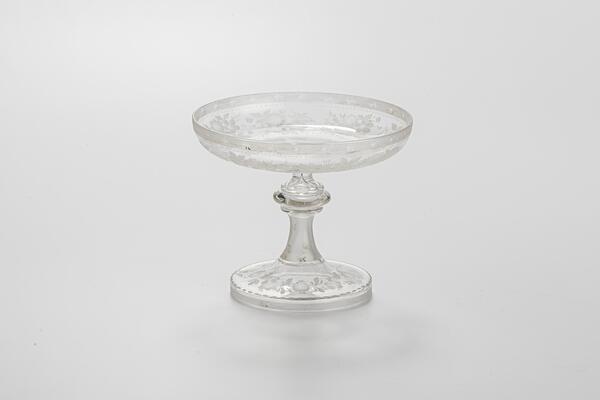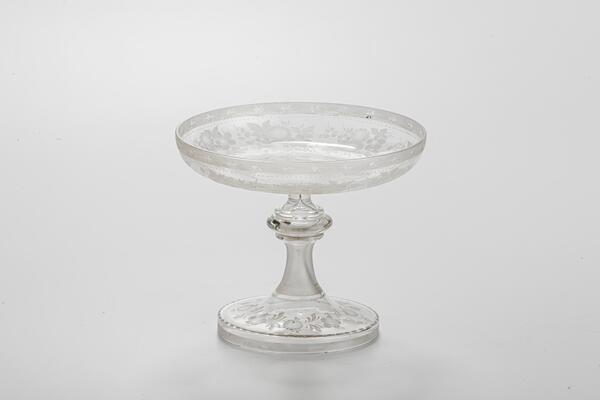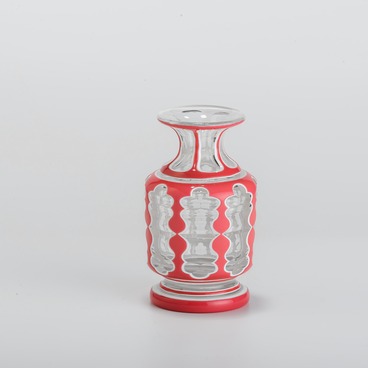Initially the Nikolsko-Bakhmetevsky glass factory offered its output to aristocratic clientele. However, in the second half of the 19th century, glass products became available to wider population groups. It was mostly everyday glassware that was in demand. But even such mundane products retained their high quality.
The bowl for biscuits, presented in the permanent exhibition, has a light matte engraving: the combination of frosted and transparent glass creates the feeling of air and lightness. The flower bouquets and small light stars make the item look elegant.
Engraving is one of the oldest types of marking the glass surface as a way of decoration. The ancient Romans and Egyptians were familiar with it, as well as Syrians and Iranians from the 8th through the 11th centuries. Since the 16th century, the technique has been widely used in Venice.
The 17th century became prominent as far as the art of engraving was concerned. Around 1600, the Prague court master Caspar Lehmann came up with the idea of using a copper wheel for carving. It had greater cutting power than the previous tools and allowed finer lines to be created. This was how the technology of milling engraving appeared, when the cutter wheels rotate on a diamond base. It became the basis of the Bohemian-Silesian school of engraving. The surface treated in this way needs no subsequent polishing.
In Russia, engraving became popular later, in the 18th century, and all large glass factories began using this technique, including the Nikolsko-Bakhmetevsky factory. At different times, vases, glasses, goblets, and sets made of colorless and colored glass with a thin openwork carved pattern were created there.
The favorite motifs of the Bakhmetevsky factory glass blowers were wild flowers, grain heads, fruit, and even thistles. Tea glasses were decorated with whole bouquets of daisies, cornflowers and roses, interspersed with intricate scrolls. Such glassware was produced at the Nikolsko-Bakhmetevsky factory until 1917. After the revolutionary events, the craftsmen of the Red Giant factory continued to work in the traditional matte engraving technique.
The bowl for biscuits, presented in the permanent exhibition, has a light matte engraving: the combination of frosted and transparent glass creates the feeling of air and lightness. The flower bouquets and small light stars make the item look elegant.
Engraving is one of the oldest types of marking the glass surface as a way of decoration. The ancient Romans and Egyptians were familiar with it, as well as Syrians and Iranians from the 8th through the 11th centuries. Since the 16th century, the technique has been widely used in Venice.
The 17th century became prominent as far as the art of engraving was concerned. Around 1600, the Prague court master Caspar Lehmann came up with the idea of using a copper wheel for carving. It had greater cutting power than the previous tools and allowed finer lines to be created. This was how the technology of milling engraving appeared, when the cutter wheels rotate on a diamond base. It became the basis of the Bohemian-Silesian school of engraving. The surface treated in this way needs no subsequent polishing.
In Russia, engraving became popular later, in the 18th century, and all large glass factories began using this technique, including the Nikolsko-Bakhmetevsky factory. At different times, vases, glasses, goblets, and sets made of colorless and colored glass with a thin openwork carved pattern were created there.
The favorite motifs of the Bakhmetevsky factory glass blowers were wild flowers, grain heads, fruit, and even thistles. Tea glasses were decorated with whole bouquets of daisies, cornflowers and roses, interspersed with intricate scrolls. Such glassware was produced at the Nikolsko-Bakhmetevsky factory until 1917. After the revolutionary events, the craftsmen of the Red Giant factory continued to work in the traditional matte engraving technique.





